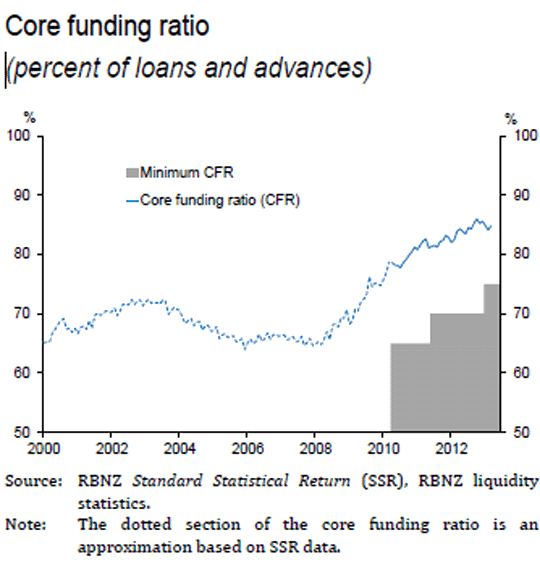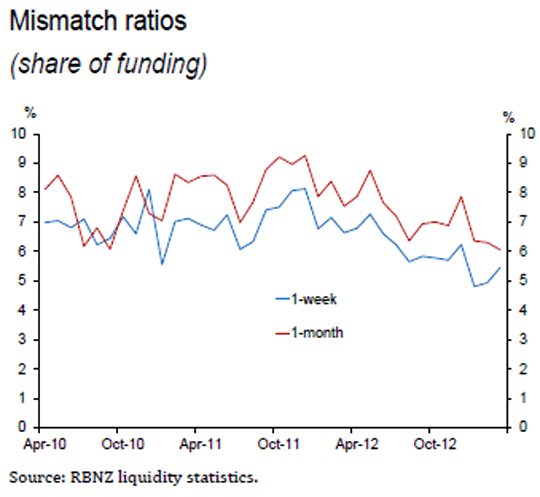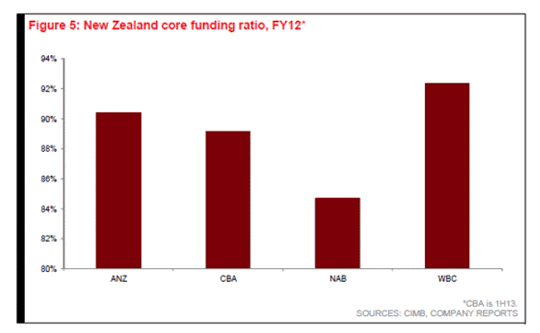By Gareth Vaughan
As the Reserve Bank mulls using the core funding ratio (CFR) as a macro-prudential tool, the latest data compiled by the central bank shows the banks, as a sector, remain comfortably north of their minimum requirement.
The latest Reserve Bank data shows that as of the end of March, locally incorporated registered banks had a combined CFR of 84.8% versus the minimum requirement of 75%. The March figure's up from 84.1% in February. The March CFR is based on core bank funding of NZ$247.695 billion and total loans and advances of NZ$292.075 billion.
Introduced in April 2010 as a move designed to reduce New Zealand banks' reliance on short-term overseas borrowing, the CFR sets out that banks must secure funding for at least 75% of their lending from equity, retail deposits, and wholesale sources such as bonds with durations of at least a year. The Reserve Bank lifted the CFR to 70% from 65% on July 1 2011, and to 75%, from January 1, 2013.
The Reserve Bank is mulling the potential use of four so-called macro-prudential tools to lessen risk in the financial system during times of rapid credit growth, rising leverage and excessive growth in asset prices. One of the four is adjustments to the minimum CFR, through which the central bank and prudential regulator could alter the amount of retail funds and longer-term wholesale funding banks have to hold. See more on the proposed macro-prudential tools here.
Since the April 2010 introduction the highest the combined CFR for locally incorporated banks was 86% in October last year, and lowest was 77.8% in July 2010.
The banks have also been subject to minimum one-week and one-month mismatch ratios since April 2010. The March ones were 5.4% for one week, which was up from 4.9% in February, and 6.1% for one month, which was down from 6.3% in February.
The aim of these ratios to make sure banks have enough cash and liquid assets accessible if creditors suddenly come knocking, or as the Reserve Bank puts it, to reduce the risk that an individual bank is brought down by a short-term loss of confidence.
The one-week mismatch ratio models what a bank’s expected cash inflows and outflows might be over the first week after a "serious" loss of confidence in the bank. To be able to meet the minimum ratio requirement, a bank must hold a sufficient stock of liquid assets to be able to fill the projected mismatch between cash inflows and outflows. Liquid assets include securities that the bank ought to be able to sell quickly and at a reliable price, such as New Zealand government bonds The one-month mismatch ratio is the same as the one-week ratio, albeit over a one-month stress period.
The Reserve Bank's Liquidity Policy sets out that neither mismatch ratio should be less than 0% at the end of each business day. The highest one week mismatch ratio so far was 8.1% in December 2010, and both November and December 2011. The lowest was 4.8% in January this year. The highest one month ratio was 9.3% in December 2011. The 6.1% recorded for March this year is equal lowest, alongside September 2010.
The figures come from monthly reports the banks must submit to the Reserve Bank. These reports cover compliance with the minimum ratios, a breakdown of liquid assets held by the banks, data on cash inflows and outflows broken down by maturity, details of new funding raised over the latest month, and the cost of that funding.


*The chart below is from an RBS Morgans research report. It shows the individual core funding ratios of the big four banks. From left to right ANZ, ASB, BNZ and Westpac.

This article was first published in our email for paid subscribers. See here for more details and to subscribe.

We welcome your comments below. If you are not already registered, please register to comment
Remember we welcome robust, respectful and insightful debate. We don't welcome abusive or defamatory comments and will de-register those repeatedly making such comments. Our current comment policy is here.